Detailed Analysis and Comparison of Investment Projects Report
VerifiedAdded on 2020/03/28
|13
|3013
|38
Project
AI Summary
This project report provides a comprehensive analysis of two investment proposals presented by Mark and Paul. The first proposal involves investing in a restaurant, with detailed sales, labor, and cash budgets developed to assess its financial performance. The report utilizes budgeting techniques to project revenue, expenses, and cash flow over a four-month period, highlighting the potential for high returns but also acknowledging practical challenges in managing high revenue. The second proposal focuses on investing in new machinery, evaluated using capital budgeting techniques such as Net Present Value (NPV), Payback Period, and Average Rate of Return (ARR). A comparative analysis is conducted to determine the superior investment opportunity, concluding that the restaurant investment offers higher profitability despite its complexities. The report emphasizes the importance of financial analysis in making informed investment decisions.
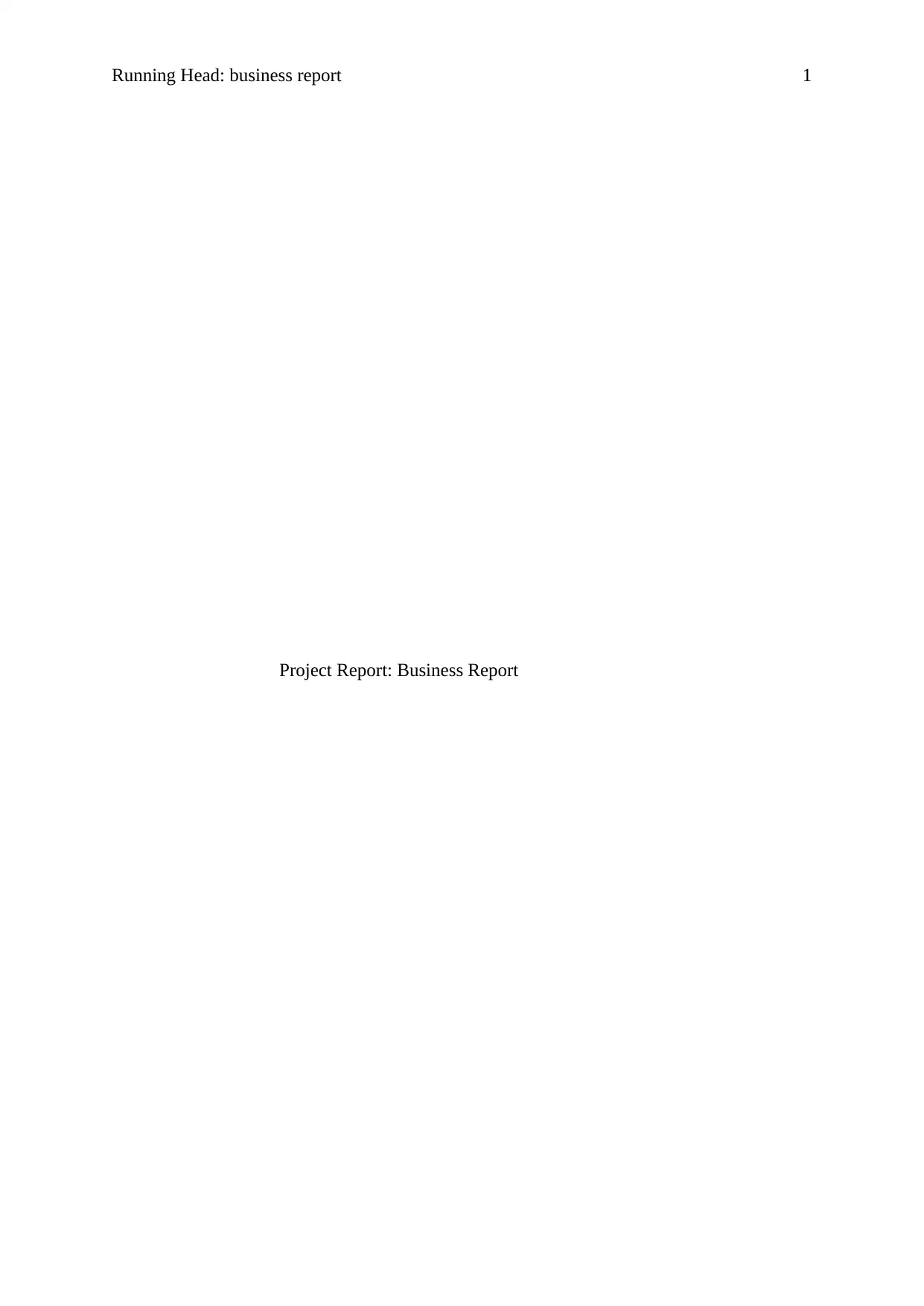
Running Head: business report 1
Project Report: Business Report
Project Report: Business Report
Paraphrase This Document
Need a fresh take? Get an instant paraphrase of this document with our AI Paraphraser
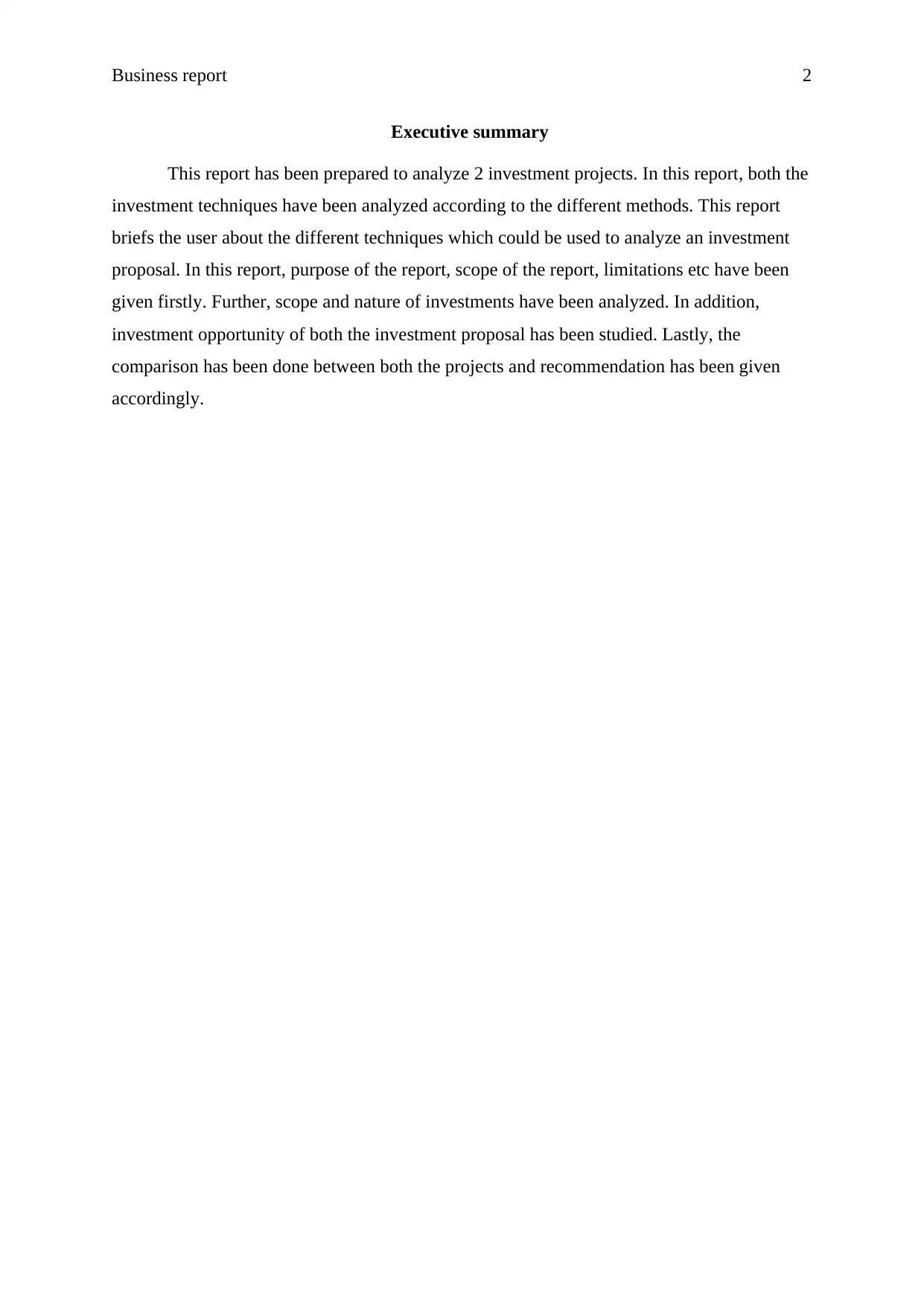
Business report 2
Executive summary
This report has been prepared to analyze 2 investment projects. In this report, both the
investment techniques have been analyzed according to the different methods. This report
briefs the user about the different techniques which could be used to analyze an investment
proposal. In this report, purpose of the report, scope of the report, limitations etc have been
given firstly. Further, scope and nature of investments have been analyzed. In addition,
investment opportunity of both the investment proposal has been studied. Lastly, the
comparison has been done between both the projects and recommendation has been given
accordingly.
Executive summary
This report has been prepared to analyze 2 investment projects. In this report, both the
investment techniques have been analyzed according to the different methods. This report
briefs the user about the different techniques which could be used to analyze an investment
proposal. In this report, purpose of the report, scope of the report, limitations etc have been
given firstly. Further, scope and nature of investments have been analyzed. In addition,
investment opportunity of both the investment proposal has been studied. Lastly, the
comparison has been done between both the projects and recommendation has been given
accordingly.
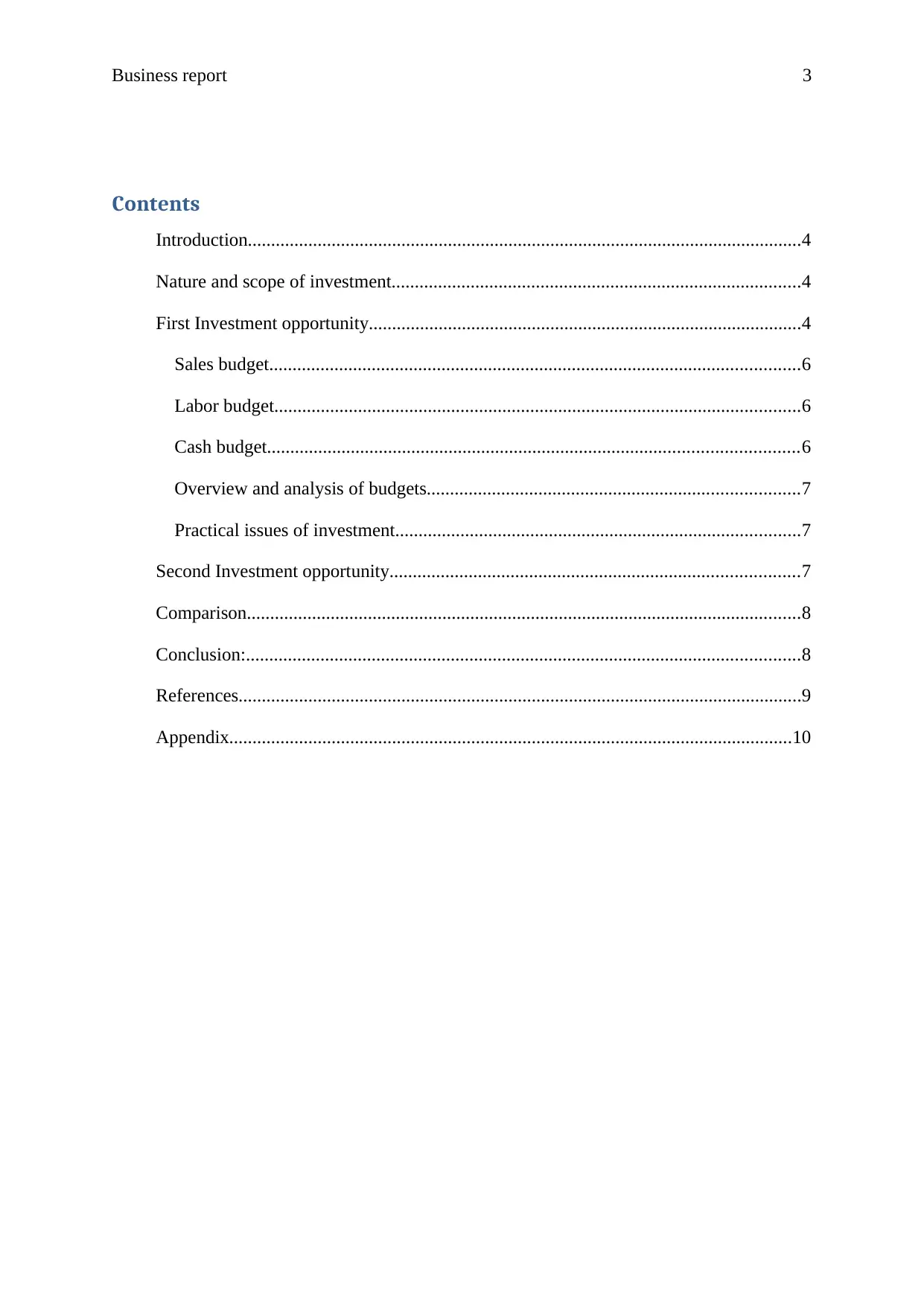
Business report 3
Contents
Introduction.......................................................................................................................4
Nature and scope of investment........................................................................................4
First Investment opportunity.............................................................................................4
Sales budget..................................................................................................................6
Labor budget.................................................................................................................6
Cash budget..................................................................................................................6
Overview and analysis of budgets................................................................................7
Practical issues of investment.......................................................................................7
Second Investment opportunity........................................................................................7
Comparison.......................................................................................................................8
Conclusion:.......................................................................................................................8
References.........................................................................................................................9
Appendix.........................................................................................................................10
Contents
Introduction.......................................................................................................................4
Nature and scope of investment........................................................................................4
First Investment opportunity.............................................................................................4
Sales budget..................................................................................................................6
Labor budget.................................................................................................................6
Cash budget..................................................................................................................6
Overview and analysis of budgets................................................................................7
Practical issues of investment.......................................................................................7
Second Investment opportunity........................................................................................7
Comparison.......................................................................................................................8
Conclusion:.......................................................................................................................8
References.........................................................................................................................9
Appendix.........................................................................................................................10
⊘ This is a preview!⊘
Do you want full access?
Subscribe today to unlock all pages.

Trusted by 1+ million students worldwide
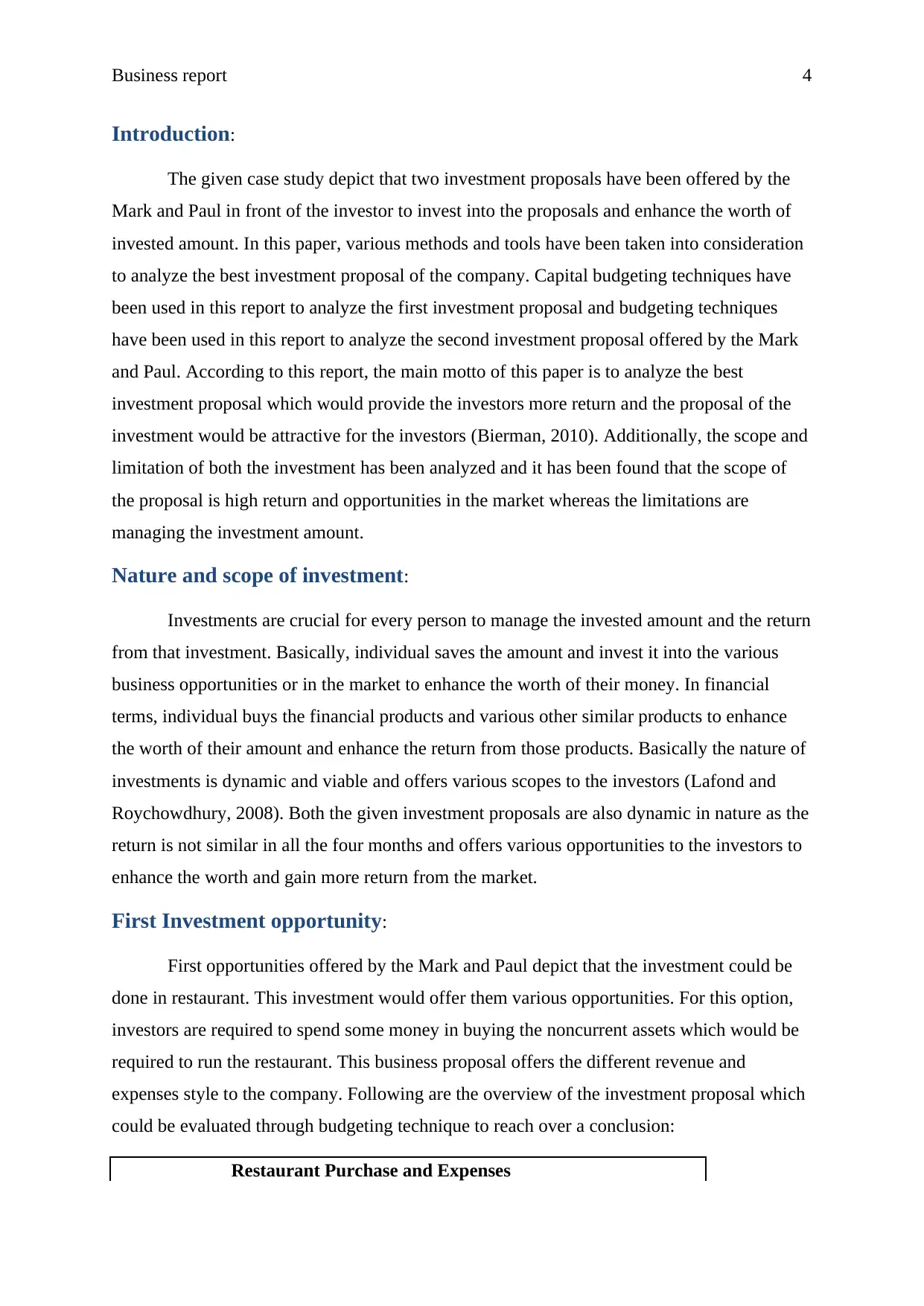
Business report 4
Introduction:
The given case study depict that two investment proposals have been offered by the
Mark and Paul in front of the investor to invest into the proposals and enhance the worth of
invested amount. In this paper, various methods and tools have been taken into consideration
to analyze the best investment proposal of the company. Capital budgeting techniques have
been used in this report to analyze the first investment proposal and budgeting techniques
have been used in this report to analyze the second investment proposal offered by the Mark
and Paul. According to this report, the main motto of this paper is to analyze the best
investment proposal which would provide the investors more return and the proposal of the
investment would be attractive for the investors (Bierman, 2010). Additionally, the scope and
limitation of both the investment has been analyzed and it has been found that the scope of
the proposal is high return and opportunities in the market whereas the limitations are
managing the investment amount.
Nature and scope of investment:
Investments are crucial for every person to manage the invested amount and the return
from that investment. Basically, individual saves the amount and invest it into the various
business opportunities or in the market to enhance the worth of their money. In financial
terms, individual buys the financial products and various other similar products to enhance
the worth of their amount and enhance the return from those products. Basically the nature of
investments is dynamic and viable and offers various scopes to the investors (Lafond and
Roychowdhury, 2008). Both the given investment proposals are also dynamic in nature as the
return is not similar in all the four months and offers various opportunities to the investors to
enhance the worth and gain more return from the market.
First Investment opportunity:
First opportunities offered by the Mark and Paul depict that the investment could be
done in restaurant. This investment would offer them various opportunities. For this option,
investors are required to spend some money in buying the noncurrent assets which would be
required to run the restaurant. This business proposal offers the different revenue and
expenses style to the company. Following are the overview of the investment proposal which
could be evaluated through budgeting technique to reach over a conclusion:
Restaurant Purchase and Expenses
Introduction:
The given case study depict that two investment proposals have been offered by the
Mark and Paul in front of the investor to invest into the proposals and enhance the worth of
invested amount. In this paper, various methods and tools have been taken into consideration
to analyze the best investment proposal of the company. Capital budgeting techniques have
been used in this report to analyze the first investment proposal and budgeting techniques
have been used in this report to analyze the second investment proposal offered by the Mark
and Paul. According to this report, the main motto of this paper is to analyze the best
investment proposal which would provide the investors more return and the proposal of the
investment would be attractive for the investors (Bierman, 2010). Additionally, the scope and
limitation of both the investment has been analyzed and it has been found that the scope of
the proposal is high return and opportunities in the market whereas the limitations are
managing the investment amount.
Nature and scope of investment:
Investments are crucial for every person to manage the invested amount and the return
from that investment. Basically, individual saves the amount and invest it into the various
business opportunities or in the market to enhance the worth of their money. In financial
terms, individual buys the financial products and various other similar products to enhance
the worth of their amount and enhance the return from those products. Basically the nature of
investments is dynamic and viable and offers various scopes to the investors (Lafond and
Roychowdhury, 2008). Both the given investment proposals are also dynamic in nature as the
return is not similar in all the four months and offers various opportunities to the investors to
enhance the worth and gain more return from the market.
First Investment opportunity:
First opportunities offered by the Mark and Paul depict that the investment could be
done in restaurant. This investment would offer them various opportunities. For this option,
investors are required to spend some money in buying the noncurrent assets which would be
required to run the restaurant. This business proposal offers the different revenue and
expenses style to the company. Following are the overview of the investment proposal which
could be evaluated through budgeting technique to reach over a conclusion:
Restaurant Purchase and Expenses
Paraphrase This Document
Need a fresh take? Get an instant paraphrase of this document with our AI Paraphraser
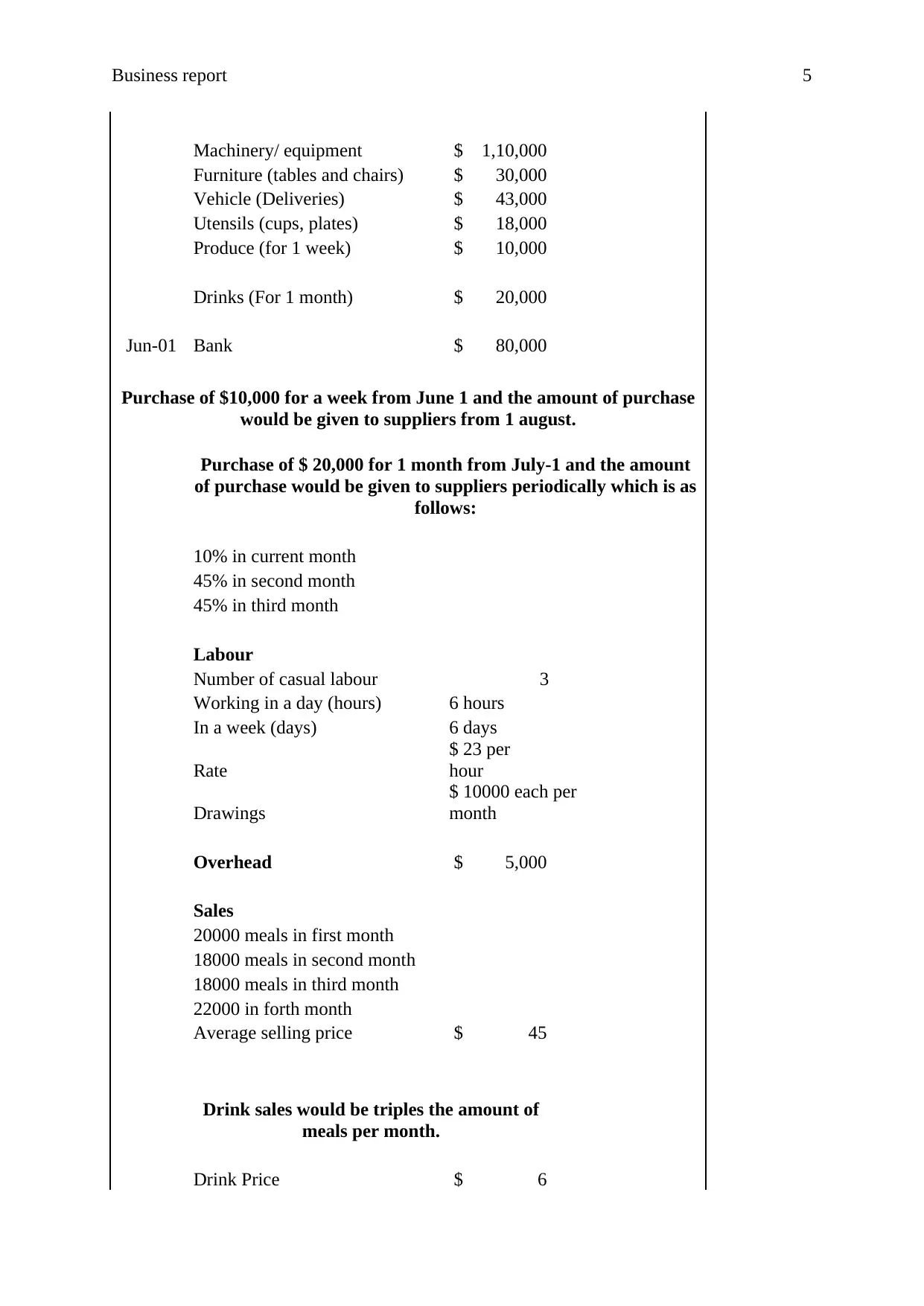
Business report 5
Machinery/ equipment $ 1,10,000
Furniture (tables and chairs) $ 30,000
Vehicle (Deliveries) $ 43,000
Utensils (cups, plates) $ 18,000
Produce (for 1 week) $ 10,000
Drinks (For 1 month) $ 20,000
Jun-01 Bank $ 80,000
Purchase of $10,000 for a week from June 1 and the amount of purchase
would be given to suppliers from 1 august.
Purchase of $ 20,000 for 1 month from July-1 and the amount
of purchase would be given to suppliers periodically which is as
follows:
10% in current month
45% in second month
45% in third month
Labour
Number of casual labour 3
Working in a day (hours) 6 hours
In a week (days) 6 days
Rate
$ 23 per
hour
Drawings
$ 10000 each per
month
Overhead $ 5,000
Sales
20000 meals in first month
18000 meals in second month
18000 meals in third month
22000 in forth month
Average selling price $ 45
Drink sales would be triples the amount of
meals per month.
Drink Price $ 6
Machinery/ equipment $ 1,10,000
Furniture (tables and chairs) $ 30,000
Vehicle (Deliveries) $ 43,000
Utensils (cups, plates) $ 18,000
Produce (for 1 week) $ 10,000
Drinks (For 1 month) $ 20,000
Jun-01 Bank $ 80,000
Purchase of $10,000 for a week from June 1 and the amount of purchase
would be given to suppliers from 1 august.
Purchase of $ 20,000 for 1 month from July-1 and the amount
of purchase would be given to suppliers periodically which is as
follows:
10% in current month
45% in second month
45% in third month
Labour
Number of casual labour 3
Working in a day (hours) 6 hours
In a week (days) 6 days
Rate
$ 23 per
hour
Drawings
$ 10000 each per
month
Overhead $ 5,000
Sales
20000 meals in first month
18000 meals in second month
18000 meals in third month
22000 in forth month
Average selling price $ 45
Drink sales would be triples the amount of
meals per month.
Drink Price $ 6
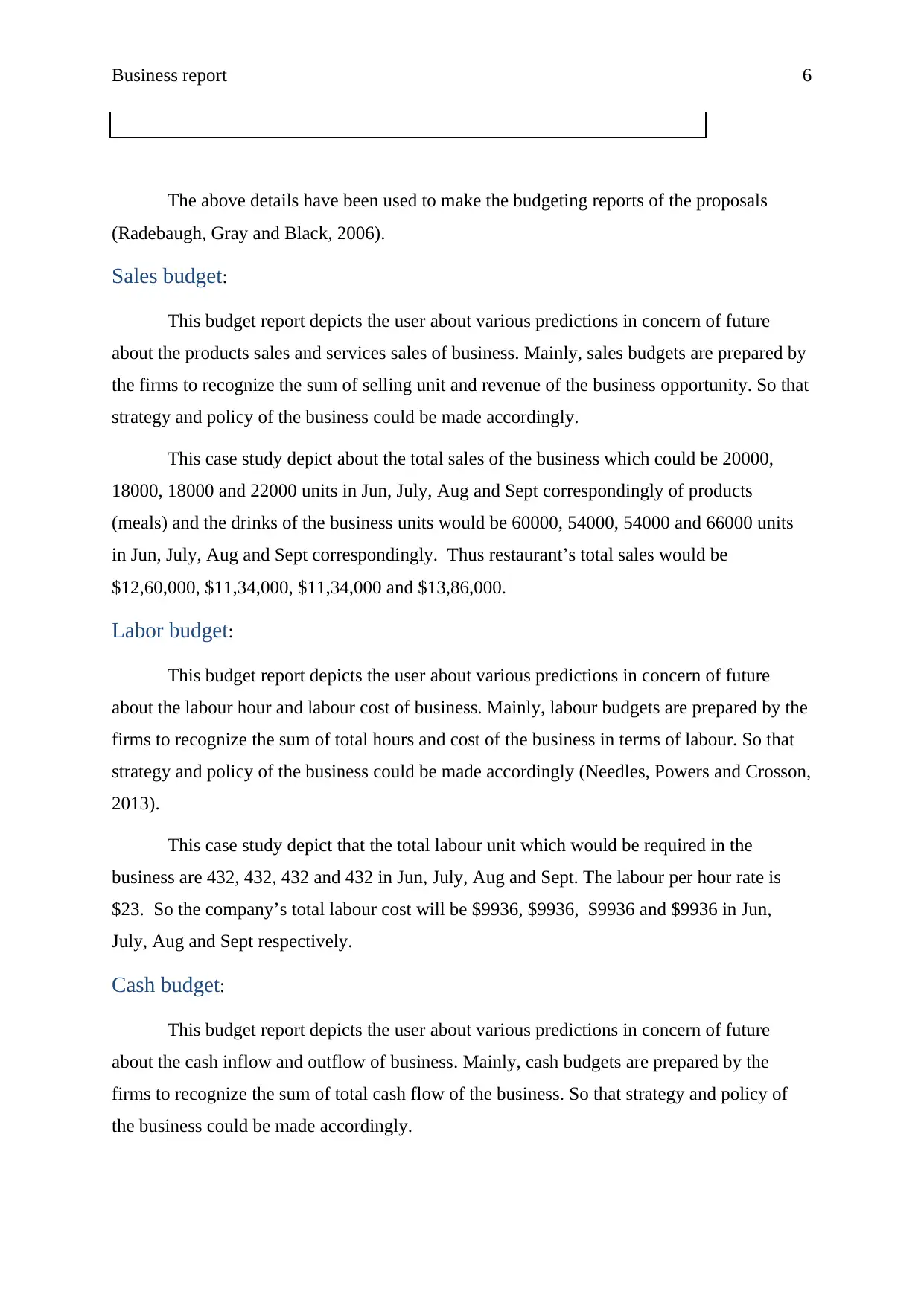
Business report 6
The above details have been used to make the budgeting reports of the proposals
(Radebaugh, Gray and Black, 2006).
Sales budget:
This budget report depicts the user about various predictions in concern of future
about the products sales and services sales of business. Mainly, sales budgets are prepared by
the firms to recognize the sum of selling unit and revenue of the business opportunity. So that
strategy and policy of the business could be made accordingly.
This case study depict about the total sales of the business which could be 20000,
18000, 18000 and 22000 units in Jun, July, Aug and Sept correspondingly of products
(meals) and the drinks of the business units would be 60000, 54000, 54000 and 66000 units
in Jun, July, Aug and Sept correspondingly. Thus restaurant’s total sales would be
$12,60,000, $11,34,000, $11,34,000 and $13,86,000.
Labor budget:
This budget report depicts the user about various predictions in concern of future
about the labour hour and labour cost of business. Mainly, labour budgets are prepared by the
firms to recognize the sum of total hours and cost of the business in terms of labour. So that
strategy and policy of the business could be made accordingly (Needles, Powers and Crosson,
2013).
This case study depict that the total labour unit which would be required in the
business are 432, 432, 432 and 432 in Jun, July, Aug and Sept. The labour per hour rate is
$23. So the company’s total labour cost will be $9936, $9936, $9936 and $9936 in Jun,
July, Aug and Sept respectively.
Cash budget:
This budget report depicts the user about various predictions in concern of future
about the cash inflow and outflow of business. Mainly, cash budgets are prepared by the
firms to recognize the sum of total cash flow of the business. So that strategy and policy of
the business could be made accordingly.
The above details have been used to make the budgeting reports of the proposals
(Radebaugh, Gray and Black, 2006).
Sales budget:
This budget report depicts the user about various predictions in concern of future
about the products sales and services sales of business. Mainly, sales budgets are prepared by
the firms to recognize the sum of selling unit and revenue of the business opportunity. So that
strategy and policy of the business could be made accordingly.
This case study depict about the total sales of the business which could be 20000,
18000, 18000 and 22000 units in Jun, July, Aug and Sept correspondingly of products
(meals) and the drinks of the business units would be 60000, 54000, 54000 and 66000 units
in Jun, July, Aug and Sept correspondingly. Thus restaurant’s total sales would be
$12,60,000, $11,34,000, $11,34,000 and $13,86,000.
Labor budget:
This budget report depicts the user about various predictions in concern of future
about the labour hour and labour cost of business. Mainly, labour budgets are prepared by the
firms to recognize the sum of total hours and cost of the business in terms of labour. So that
strategy and policy of the business could be made accordingly (Needles, Powers and Crosson,
2013).
This case study depict that the total labour unit which would be required in the
business are 432, 432, 432 and 432 in Jun, July, Aug and Sept. The labour per hour rate is
$23. So the company’s total labour cost will be $9936, $9936, $9936 and $9936 in Jun,
July, Aug and Sept respectively.
Cash budget:
This budget report depicts the user about various predictions in concern of future
about the cash inflow and outflow of business. Mainly, cash budgets are prepared by the
firms to recognize the sum of total cash flow of the business. So that strategy and policy of
the business could be made accordingly.
⊘ This is a preview!⊘
Do you want full access?
Subscribe today to unlock all pages.

Trusted by 1+ million students worldwide
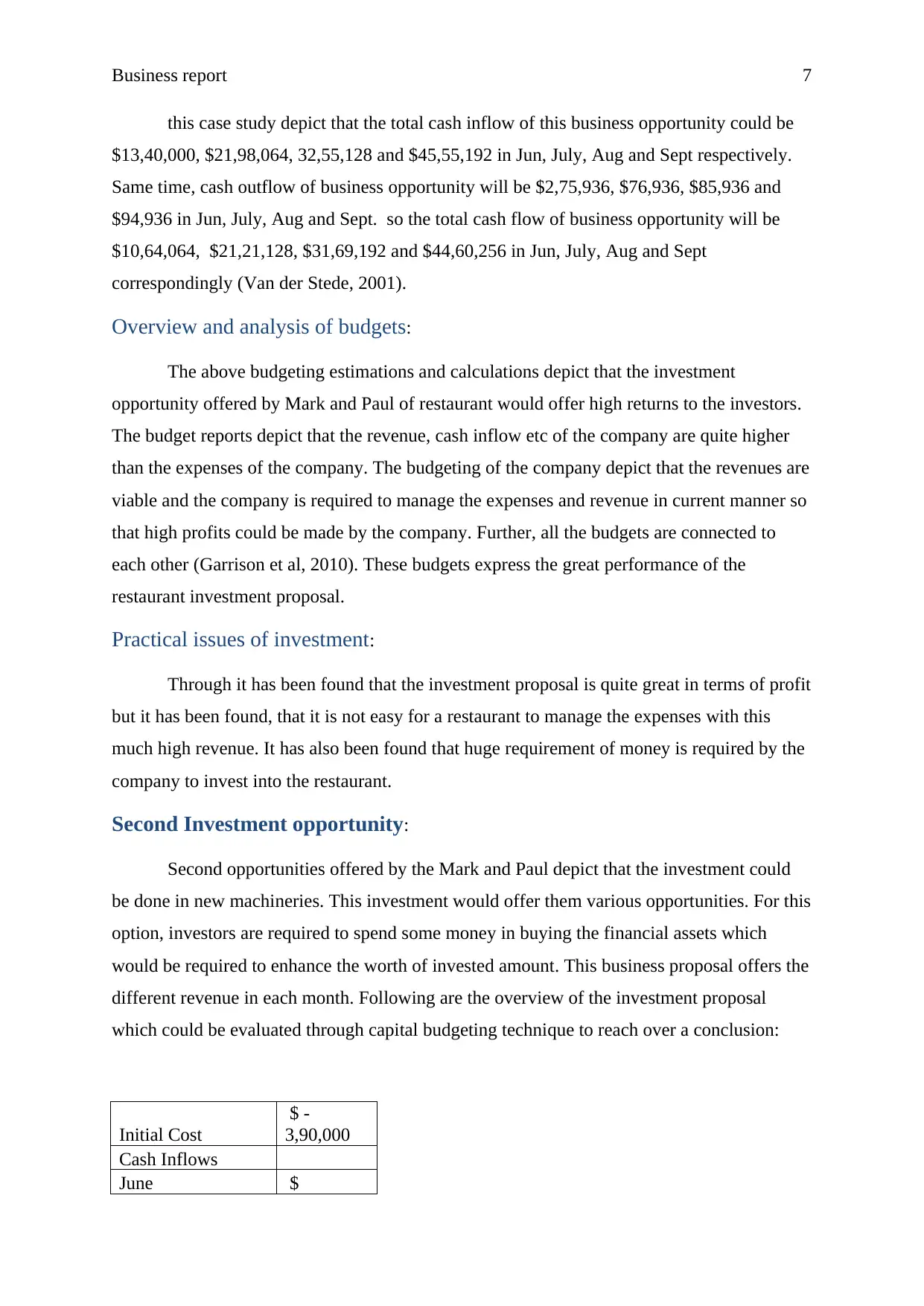
Business report 7
this case study depict that the total cash inflow of this business opportunity could be
$13,40,000, $21,98,064, 32,55,128 and $45,55,192 in Jun, July, Aug and Sept respectively.
Same time, cash outflow of business opportunity will be $2,75,936, $76,936, $85,936 and
$94,936 in Jun, July, Aug and Sept. so the total cash flow of business opportunity will be
$10,64,064, $21,21,128, $31,69,192 and $44,60,256 in Jun, July, Aug and Sept
correspondingly (Van der Stede, 2001).
Overview and analysis of budgets:
The above budgeting estimations and calculations depict that the investment
opportunity offered by Mark and Paul of restaurant would offer high returns to the investors.
The budget reports depict that the revenue, cash inflow etc of the company are quite higher
than the expenses of the company. The budgeting of the company depict that the revenues are
viable and the company is required to manage the expenses and revenue in current manner so
that high profits could be made by the company. Further, all the budgets are connected to
each other (Garrison et al, 2010). These budgets express the great performance of the
restaurant investment proposal.
Practical issues of investment:
Through it has been found that the investment proposal is quite great in terms of profit
but it has been found, that it is not easy for a restaurant to manage the expenses with this
much high revenue. It has also been found that huge requirement of money is required by the
company to invest into the restaurant.
Second Investment opportunity:
Second opportunities offered by the Mark and Paul depict that the investment could
be done in new machineries. This investment would offer them various opportunities. For this
option, investors are required to spend some money in buying the financial assets which
would be required to enhance the worth of invested amount. This business proposal offers the
different revenue in each month. Following are the overview of the investment proposal
which could be evaluated through capital budgeting technique to reach over a conclusion:
Initial Cost
$ -
3,90,000
Cash Inflows
June $
this case study depict that the total cash inflow of this business opportunity could be
$13,40,000, $21,98,064, 32,55,128 and $45,55,192 in Jun, July, Aug and Sept respectively.
Same time, cash outflow of business opportunity will be $2,75,936, $76,936, $85,936 and
$94,936 in Jun, July, Aug and Sept. so the total cash flow of business opportunity will be
$10,64,064, $21,21,128, $31,69,192 and $44,60,256 in Jun, July, Aug and Sept
correspondingly (Van der Stede, 2001).
Overview and analysis of budgets:
The above budgeting estimations and calculations depict that the investment
opportunity offered by Mark and Paul of restaurant would offer high returns to the investors.
The budget reports depict that the revenue, cash inflow etc of the company are quite higher
than the expenses of the company. The budgeting of the company depict that the revenues are
viable and the company is required to manage the expenses and revenue in current manner so
that high profits could be made by the company. Further, all the budgets are connected to
each other (Garrison et al, 2010). These budgets express the great performance of the
restaurant investment proposal.
Practical issues of investment:
Through it has been found that the investment proposal is quite great in terms of profit
but it has been found, that it is not easy for a restaurant to manage the expenses with this
much high revenue. It has also been found that huge requirement of money is required by the
company to invest into the restaurant.
Second Investment opportunity:
Second opportunities offered by the Mark and Paul depict that the investment could
be done in new machineries. This investment would offer them various opportunities. For this
option, investors are required to spend some money in buying the financial assets which
would be required to enhance the worth of invested amount. This business proposal offers the
different revenue in each month. Following are the overview of the investment proposal
which could be evaluated through capital budgeting technique to reach over a conclusion:
Initial Cost
$ -
3,90,000
Cash Inflows
June $
Paraphrase This Document
Need a fresh take? Get an instant paraphrase of this document with our AI Paraphraser
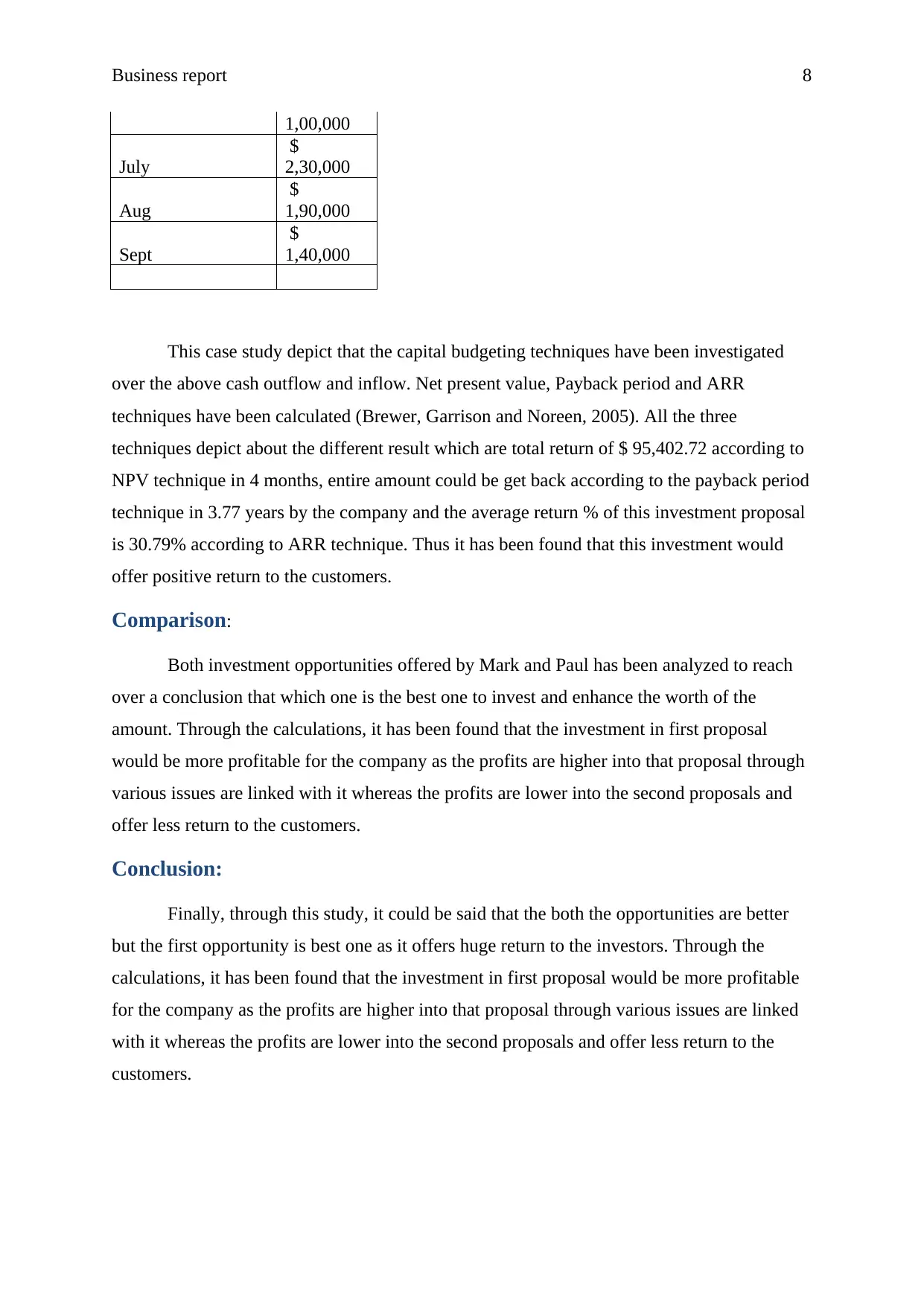
Business report 8
1,00,000
July
$
2,30,000
Aug
$
1,90,000
Sept
$
1,40,000
This case study depict that the capital budgeting techniques have been investigated
over the above cash outflow and inflow. Net present value, Payback period and ARR
techniques have been calculated (Brewer, Garrison and Noreen, 2005). All the three
techniques depict about the different result which are total return of $ 95,402.72 according to
NPV technique in 4 months, entire amount could be get back according to the payback period
technique in 3.77 years by the company and the average return % of this investment proposal
is 30.79% according to ARR technique. Thus it has been found that this investment would
offer positive return to the customers.
Comparison:
Both investment opportunities offered by Mark and Paul has been analyzed to reach
over a conclusion that which one is the best one to invest and enhance the worth of the
amount. Through the calculations, it has been found that the investment in first proposal
would be more profitable for the company as the profits are higher into that proposal through
various issues are linked with it whereas the profits are lower into the second proposals and
offer less return to the customers.
Conclusion:
Finally, through this study, it could be said that the both the opportunities are better
but the first opportunity is best one as it offers huge return to the investors. Through the
calculations, it has been found that the investment in first proposal would be more profitable
for the company as the profits are higher into that proposal through various issues are linked
with it whereas the profits are lower into the second proposals and offer less return to the
customers.
1,00,000
July
$
2,30,000
Aug
$
1,90,000
Sept
$
1,40,000
This case study depict that the capital budgeting techniques have been investigated
over the above cash outflow and inflow. Net present value, Payback period and ARR
techniques have been calculated (Brewer, Garrison and Noreen, 2005). All the three
techniques depict about the different result which are total return of $ 95,402.72 according to
NPV technique in 4 months, entire amount could be get back according to the payback period
technique in 3.77 years by the company and the average return % of this investment proposal
is 30.79% according to ARR technique. Thus it has been found that this investment would
offer positive return to the customers.
Comparison:
Both investment opportunities offered by Mark and Paul has been analyzed to reach
over a conclusion that which one is the best one to invest and enhance the worth of the
amount. Through the calculations, it has been found that the investment in first proposal
would be more profitable for the company as the profits are higher into that proposal through
various issues are linked with it whereas the profits are lower into the second proposals and
offer less return to the customers.
Conclusion:
Finally, through this study, it could be said that the both the opportunities are better
but the first opportunity is best one as it offers huge return to the investors. Through the
calculations, it has been found that the investment in first proposal would be more profitable
for the company as the profits are higher into that proposal through various issues are linked
with it whereas the profits are lower into the second proposals and offer less return to the
customers.
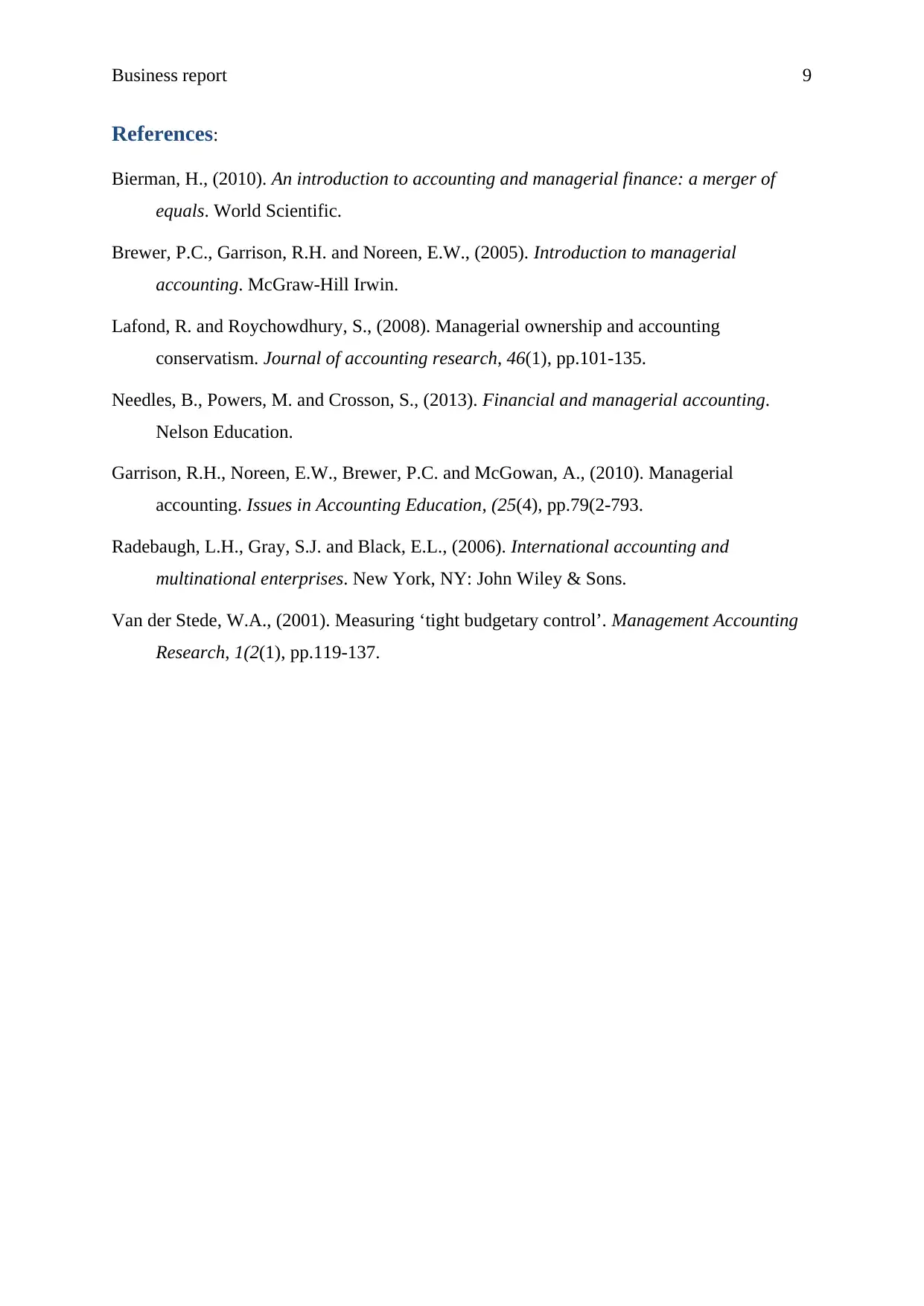
Business report 9
References:
Bierman, H., (2010). An introduction to accounting and managerial finance: a merger of
equals. World Scientific.
Brewer, P.C., Garrison, R.H. and Noreen, E.W., (2005). Introduction to managerial
accounting. McGraw-Hill Irwin.
Lafond, R. and Roychowdhury, S., (2008). Managerial ownership and accounting
conservatism. Journal of accounting research, 46(1), pp.101-135.
Needles, B., Powers, M. and Crosson, S., (2013). Financial and managerial accounting.
Nelson Education.
Garrison, R.H., Noreen, E.W., Brewer, P.C. and McGowan, A., (2010). Managerial
accounting. Issues in Accounting Education, (25(4), pp.79(2-793.
Radebaugh, L.H., Gray, S.J. and Black, E.L., (2006). International accounting and
multinational enterprises. New York, NY: John Wiley & Sons.
Van der Stede, W.A., (2001). Measuring ‘tight budgetary control’. Management Accounting
Research, 1(2(1), pp.119-137.
References:
Bierman, H., (2010). An introduction to accounting and managerial finance: a merger of
equals. World Scientific.
Brewer, P.C., Garrison, R.H. and Noreen, E.W., (2005). Introduction to managerial
accounting. McGraw-Hill Irwin.
Lafond, R. and Roychowdhury, S., (2008). Managerial ownership and accounting
conservatism. Journal of accounting research, 46(1), pp.101-135.
Needles, B., Powers, M. and Crosson, S., (2013). Financial and managerial accounting.
Nelson Education.
Garrison, R.H., Noreen, E.W., Brewer, P.C. and McGowan, A., (2010). Managerial
accounting. Issues in Accounting Education, (25(4), pp.79(2-793.
Radebaugh, L.H., Gray, S.J. and Black, E.L., (2006). International accounting and
multinational enterprises. New York, NY: John Wiley & Sons.
Van der Stede, W.A., (2001). Measuring ‘tight budgetary control’. Management Accounting
Research, 1(2(1), pp.119-137.
⊘ This is a preview!⊘
Do you want full access?
Subscribe today to unlock all pages.

Trusted by 1+ million students worldwide
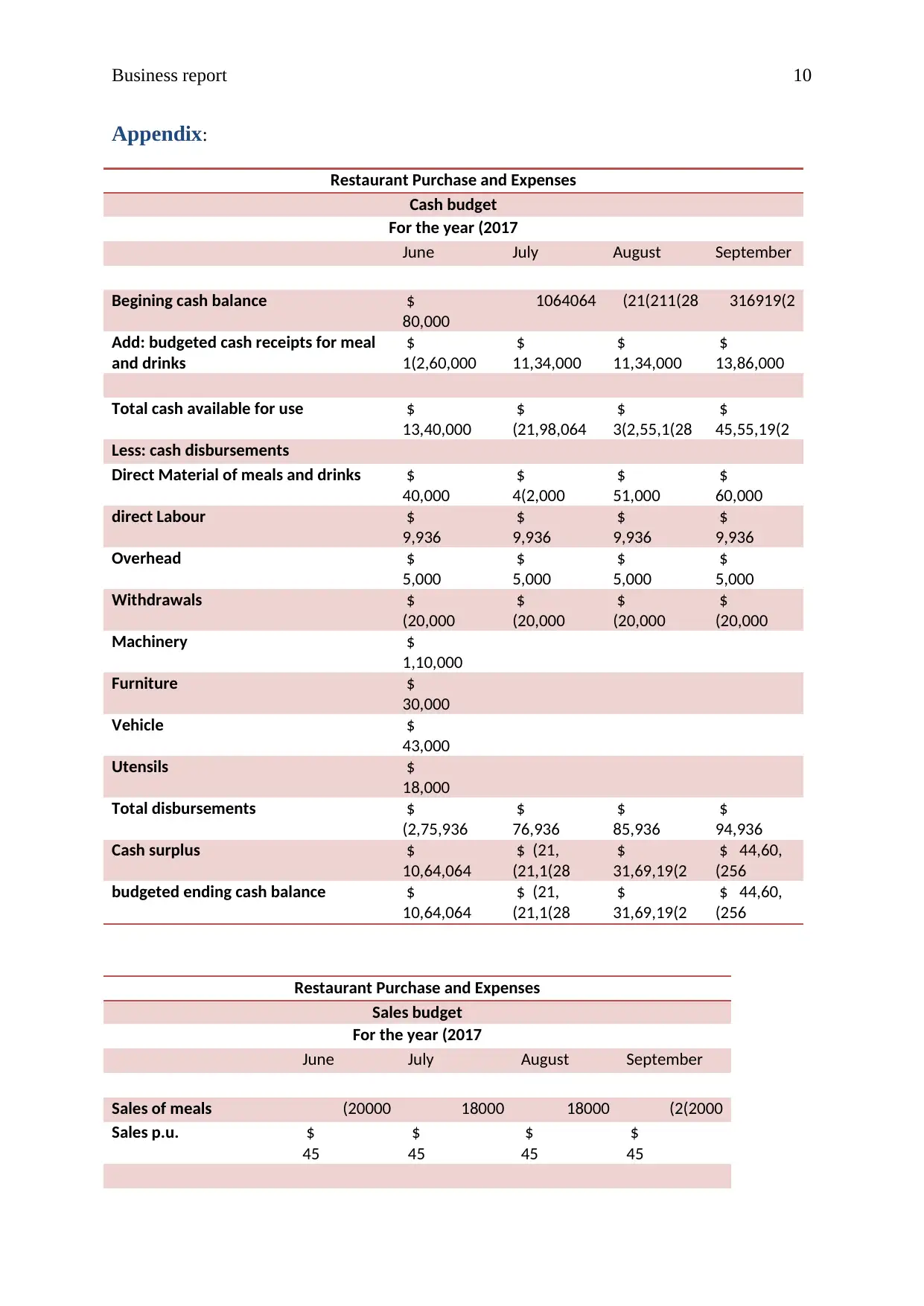
Business report 10
Appendix:
Restaurant Purchase and Expenses
Cash budget
For the year (2017
June July August September
Begining cash balance $
80,000
1064064 (21(211(28 316919(2
Add: budgeted cash receipts for meal
and drinks
$
1(2,60,000
$
11,34,000
$
11,34,000
$
13,86,000
Total cash available for use $
13,40,000
$
(21,98,064
$
3(2,55,1(28
$
45,55,19(2
Less: cash disbursements
Direct Material of meals and drinks $
40,000
$
4(2,000
$
51,000
$
60,000
direct Labour $
9,936
$
9,936
$
9,936
$
9,936
Overhead $
5,000
$
5,000
$
5,000
$
5,000
Withdrawals $
(20,000
$
(20,000
$
(20,000
$
(20,000
Machinery $
1,10,000
Furniture $
30,000
Vehicle $
43,000
Utensils $
18,000
Total disbursements $
(2,75,936
$
76,936
$
85,936
$
94,936
Cash surplus $
10,64,064
$ (21,
(21,1(28
$
31,69,19(2
$ 44,60,
(256
budgeted ending cash balance $
10,64,064
$ (21,
(21,1(28
$
31,69,19(2
$ 44,60,
(256
Restaurant Purchase and Expenses
Sales budget
For the year (2017
June July August September
Sales of meals (20000 18000 18000 (2(2000
Sales p.u. $
45
$
45
$
45
$
45
Appendix:
Restaurant Purchase and Expenses
Cash budget
For the year (2017
June July August September
Begining cash balance $
80,000
1064064 (21(211(28 316919(2
Add: budgeted cash receipts for meal
and drinks
$
1(2,60,000
$
11,34,000
$
11,34,000
$
13,86,000
Total cash available for use $
13,40,000
$
(21,98,064
$
3(2,55,1(28
$
45,55,19(2
Less: cash disbursements
Direct Material of meals and drinks $
40,000
$
4(2,000
$
51,000
$
60,000
direct Labour $
9,936
$
9,936
$
9,936
$
9,936
Overhead $
5,000
$
5,000
$
5,000
$
5,000
Withdrawals $
(20,000
$
(20,000
$
(20,000
$
(20,000
Machinery $
1,10,000
Furniture $
30,000
Vehicle $
43,000
Utensils $
18,000
Total disbursements $
(2,75,936
$
76,936
$
85,936
$
94,936
Cash surplus $
10,64,064
$ (21,
(21,1(28
$
31,69,19(2
$ 44,60,
(256
budgeted ending cash balance $
10,64,064
$ (21,
(21,1(28
$
31,69,19(2
$ 44,60,
(256
Restaurant Purchase and Expenses
Sales budget
For the year (2017
June July August September
Sales of meals (20000 18000 18000 (2(2000
Sales p.u. $
45
$
45
$
45
$
45
Paraphrase This Document
Need a fresh take? Get an instant paraphrase of this document with our AI Paraphraser
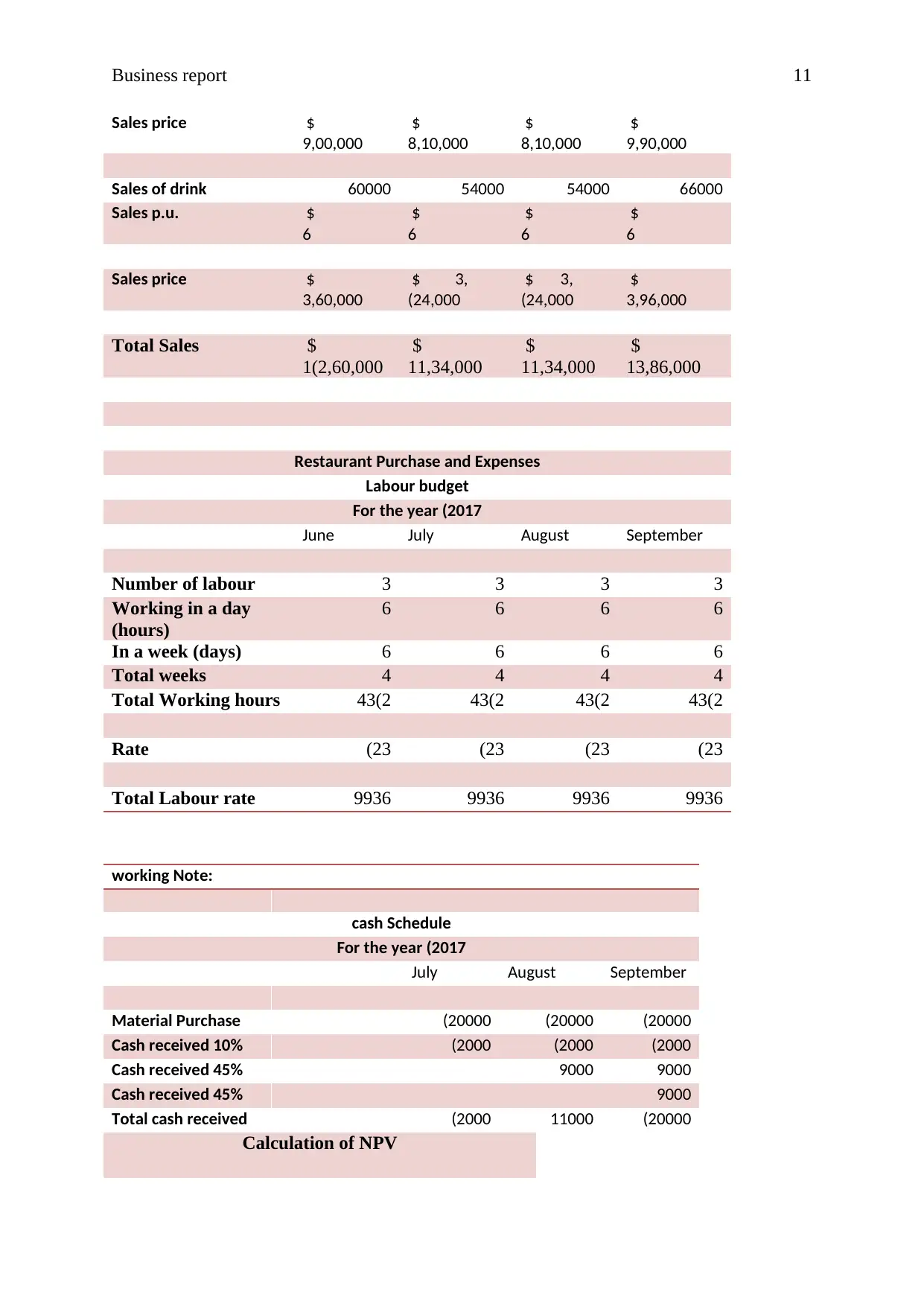
Business report 11
Sales price $
9,00,000
$
8,10,000
$
8,10,000
$
9,90,000
Sales of drink 60000 54000 54000 66000
Sales p.u. $
6
$
6
$
6
$
6
Sales price $
3,60,000
$ 3,
(24,000
$ 3,
(24,000
$
3,96,000
Total Sales $
1(2,60,000
$
11,34,000
$
11,34,000
$
13,86,000
Restaurant Purchase and Expenses
Labour budget
For the year (2017
June July August September
Number of labour 3 3 3 3
Working in a day
(hours)
6 6 6 6
In a week (days) 6 6 6 6
Total weeks 4 4 4 4
Total Working hours 43(2 43(2 43(2 43(2
Rate (23 (23 (23 (23
Total Labour rate 9936 9936 9936 9936
working Note:
cash Schedule
For the year (2017
July August September
Material Purchase (20000 (20000 (20000
Cash received 10% (2000 (2000 (2000
Cash received 45% 9000 9000
Cash received 45% 9000
Total cash received (2000 11000 (20000
Calculation of NPV
Sales price $
9,00,000
$
8,10,000
$
8,10,000
$
9,90,000
Sales of drink 60000 54000 54000 66000
Sales p.u. $
6
$
6
$
6
$
6
Sales price $
3,60,000
$ 3,
(24,000
$ 3,
(24,000
$
3,96,000
Total Sales $
1(2,60,000
$
11,34,000
$
11,34,000
$
13,86,000
Restaurant Purchase and Expenses
Labour budget
For the year (2017
June July August September
Number of labour 3 3 3 3
Working in a day
(hours)
6 6 6 6
In a week (days) 6 6 6 6
Total weeks 4 4 4 4
Total Working hours 43(2 43(2 43(2 43(2
Rate (23 (23 (23 (23
Total Labour rate 9936 9936 9936 9936
working Note:
cash Schedule
For the year (2017
July August September
Material Purchase (20000 (20000 (20000
Cash received 10% (2000 (2000 (2000
Cash received 45% 9000 9000
Cash received 45% 9000
Total cash received (2000 11000 (20000
Calculation of NPV
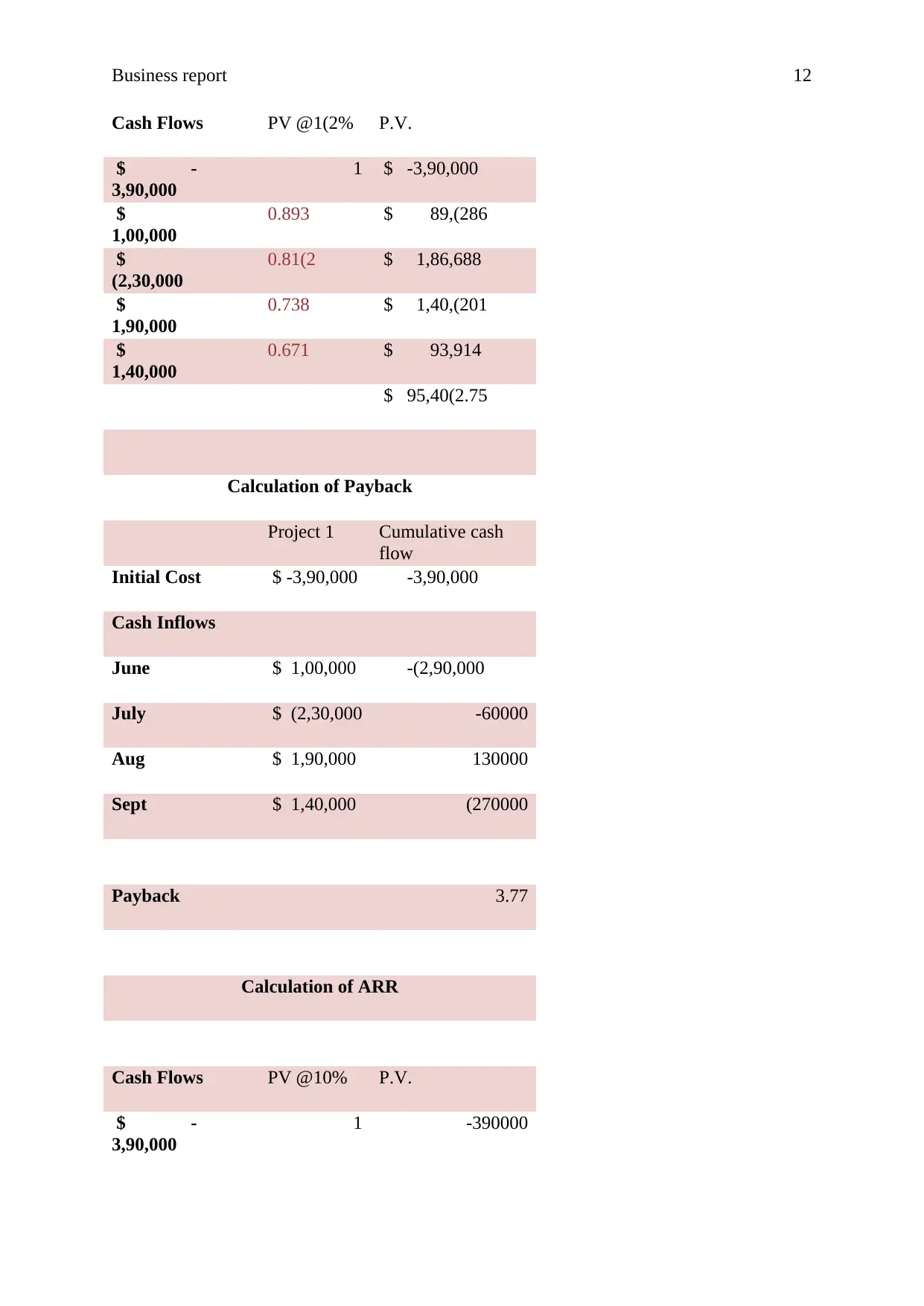
Business report 12
Cash Flows PV @1(2% P.V.
$ -
3,90,000
1 $ -3,90,000
$
1,00,000
0.893 $ 89,(286
$
(2,30,000
0.81(2 $ 1,86,688
$
1,90,000
0.738 $ 1,40,(201
$
1,40,000
0.671 $ 93,914
$ 95,40(2.75
Calculation of Payback
Project 1 Cumulative cash
flow
Initial Cost $ -3,90,000 -3,90,000
Cash Inflows
June $ 1,00,000 -(2,90,000
July $ (2,30,000 -60000
Aug $ 1,90,000 130000
Sept $ 1,40,000 (270000
Payback 3.77
Calculation of ARR
Cash Flows PV @10% P.V.
$ -
3,90,000
1 -390000
Cash Flows PV @1(2% P.V.
$ -
3,90,000
1 $ -3,90,000
$
1,00,000
0.893 $ 89,(286
$
(2,30,000
0.81(2 $ 1,86,688
$
1,90,000
0.738 $ 1,40,(201
$
1,40,000
0.671 $ 93,914
$ 95,40(2.75
Calculation of Payback
Project 1 Cumulative cash
flow
Initial Cost $ -3,90,000 -3,90,000
Cash Inflows
June $ 1,00,000 -(2,90,000
July $ (2,30,000 -60000
Aug $ 1,90,000 130000
Sept $ 1,40,000 (270000
Payback 3.77
Calculation of ARR
Cash Flows PV @10% P.V.
$ -
3,90,000
1 -390000
⊘ This is a preview!⊘
Do you want full access?
Subscribe today to unlock all pages.

Trusted by 1+ million students worldwide
1 out of 13
Related Documents
Your All-in-One AI-Powered Toolkit for Academic Success.
+13062052269
info@desklib.com
Available 24*7 on WhatsApp / Email
![[object Object]](/_next/static/media/star-bottom.7253800d.svg)
Unlock your academic potential
Copyright © 2020–2025 A2Z Services. All Rights Reserved. Developed and managed by ZUCOL.





